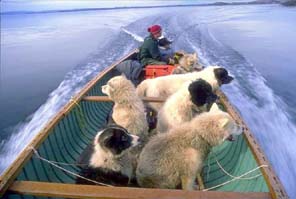Table of Contents
*
Featured Inuit Dog Owner: Ken MacRury, Part 1
*
Remembering Niya
*
Page from the Behaviour Notebook: Bishop and Tunaq
*
Antarctic Vignettes
*
On Managing ISD Aggression
*
The Qitdlarssuaq Chronicles, Part 3
*
News Briefs:
Inuit Dog Thesis Back in Print
Nunavut Quest 2003 Report
Article in Mushing Magazine
Possible Smithsonian Magazine Story
*
Product Review: Dismutase
*
Tip for the Trail: Insect Repellents
*
Book Review: The New Guide to Breeding
Old Fashioned Working Dogs
*
Video Review: Stonington Island, Antarctica 1957-58
*
IMHO: The Slippery Slope
Navigating This
Site
Index of articles by subject
Index
of back issues by volume number
Search The
Fan Hitch
Articles
to download and print
Ordering
Ken MacRury's Thesis
Our
comprehensive list of resources
Talk
to The
Fan Hitch
The Fan
Hitch home page
ISDI
home page
Editor: Sue Hamilton
Webmaster: Mark Hamilton
Contents of The Fan Hitch Website and its publications are protected by international copyright laws. No photo, drawing or text may be reproduced in any form without written consent. Webmasters please note: written consent is necessary before linking this site to yours! Please forward requests to Sue Hamilton, 55 Town Line Rd., Harwinton, Connecticut 06791, USA or mail@thefanhitch.org

Corel
photo
The Slippery Slope
by Mark Hamilton
There's a saying that "If the only tool you have is a hammer, more than likely every problem will look like a nail". Human behavior is rife with examples of how it conforms to this adage. One such behavior is the tendency of our species to look for justification (evidence) that supports our preexisting behaviors or beliefs… and dismiss any "odd facts" that challenge or prove the opposite side. Yup, we'll cling to that ole' hammer like it was a life preserver.
Recently, I had the opportunity to meet and speak with Martin Buser. Some of you even now are probably thinking this sounds like an "oil and water" situation, an Iditarod musher (winner, in fact) and someone whose idea of fun is expedition style travel with Inuit Dogs up in the high Arctic. It's very easy to point out the differences in our interests, but beneath it all are the sled dogs, mushing and training - areas of commonality. Let me say this right now about Martin Buser, he's a dog trainer and I think it's likely we all might learn something from him.
Me, I'm still working on my "dog trainer" credentials. The first time I became aware of my shortcomings as a trainer was when a horse trainer acquaintance of mine was taking a sled ride with me, and said something like: "You should hear yourself, you're yelling and hollering." I thought I was just encouraging the dogs (Malamutes, back then) along. I guess at some level, I must have decided they were all hard of hearing. Subsequent dog trips in the Arctic with experienced Inuit dog drivers have demonstrated to me that most dogs are not hard of hearing and that encouragement, when needed, can be a quiet activity, just like giving any other command.
During Martin's presentation to a group made up primarily of sprint racers, he concentrated on the concept of training one's dogs for even the most basic of behaviors, like eating and drinking. Of particular interest to me was when he challenged one of my favorite long held beliefs: that only a select few dogs are capable of being lead dogs. He categorically stated that lead dogs are easily created through simple training, and backed it up by offering that most of his dogs are capable of leading. That definitely was not my position - then.
I have to tell you, I find it hard to defend a position about dog training when the other person can support their viewpoint by having won the Iditarod with dogs exhibiting the action I thought impossible. I now find myself thinking more about what else I can or want to train my dogs to do, and prioritizing those wishes.
I also understand that this realization has me standing on the brink of a very slippery slope. After I train my dogs to do the tasks on my new "wish list", surely the step after that is to also select breeding stock on the basis of achieving those tasks. That's fine too, as long as the tasks I require are the basis for a "working sled dog".
What is a "working sled dog"? It's one that can survive in the Arctic under the harsh conditions that imposes on them, proving themselves in harness, on the ice, in a team. That ole' slippery slope starts exactly at the point where I decide to select for any characteristic or behavior other than those of a "working sled dog". Selecting for softer, more manageable, more compliant temperaments is as destructive as selecting for darker eyes, or more uniform markings.
It's an easy concept, if I want my dogs to be easier to
live with, quieter,
more reliable around children and seniors, my only choice
is to train them
to be that way. It's a good thing I enjoy being outside
with my dogs.